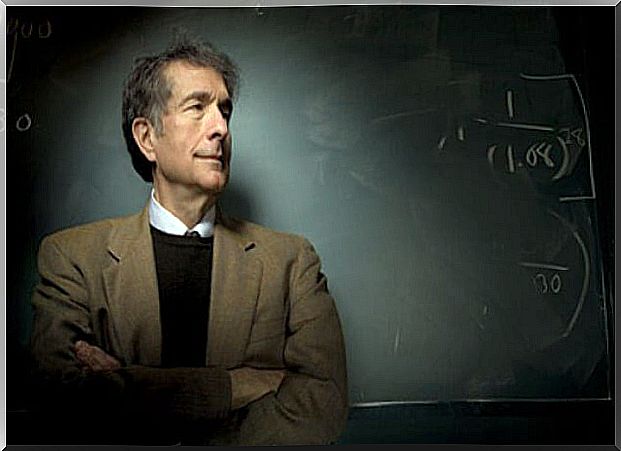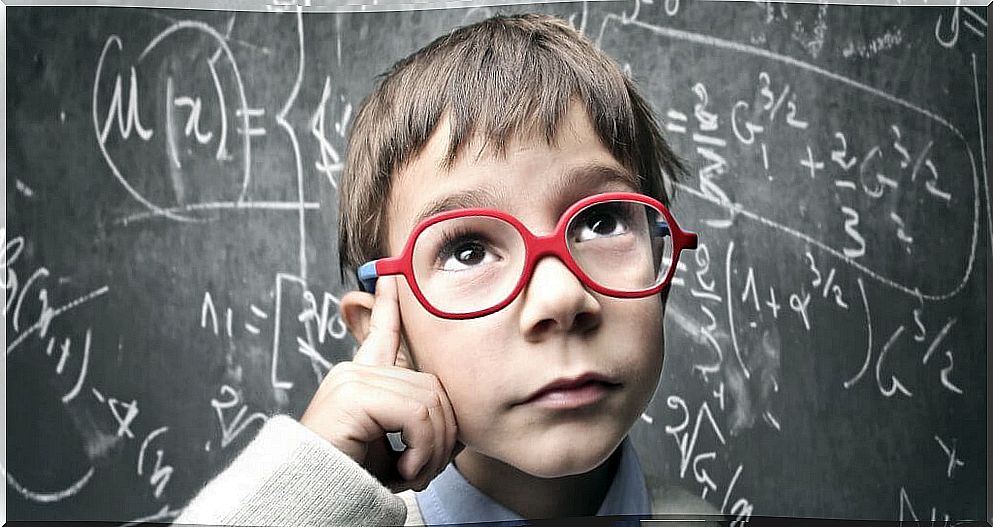Howard Gardner And His Theory On Multiple Intelligences

For decades it was thought that intelligence was a unitary mental function that described our ability to solve problems, mainly in the logical-mathematical area. However, almost three decades ago Howard Gardner questioned this idea and did so with good arguments. His alternative to the global conception of intelligence was the theory of multiple intelligences.
Thus, Gardner realized that people did not have a global intelligence that could be applied to all spheres of their life, but developed different types of intelligences which he called multiple intelligences. In this way, the latest theories in psychology on the multiplicity of intelligences leave behind the more classical, and probably unfair, conception of intelligence.
Definition of intelligence according to Gardner
Academic brilliance isn’t everything
Gardner defines intelligence as the “ability to solve problems or produce products that are valuable in one or more cultures. ” Thus, first, it broadens the field of what intelligence is and recognizes what was intuitively known, that some kinds of intelligence are related to academic performance, but that there are others, no less important, that are not. At least not directly and as intelligence has been assessed in a traditional way.
On the other hand, the academic record is not usually the variable that best predicts how a person will develop in life. There are people who score very high in the classic intelligence tests, but who are unable, for example, to perform a minimum of skill when choosing their social relationships.
Intelligence is a skill that can be developed
Second, and not least, Gardner defines intelligence as a capacity. Until very recently, intelligence was considered something innate and immovable. You were born smart or not, and education couldn’t change that fact. So much so that in times very close to the mentally handicapped they were not educated, because it was considered to be a useless effort.
Defining intelligence as an ability makes it a skill that can be developed. Gardner does not deny the genetic component, but maintains that these potentialities will develop in one way or another depending on the environment, lived experiences, education received, etc.

Theory of multiple intelligences: 8 types of intelligence
Logical-mathematical intelligence
It is defined as the ability to understand abstract relationships. We use it to solve logic and math problems. It corresponds to the way of thinking of the logical hemisphere and with what our culture has always considered as the only intelligence (Morchio, 2004: 4).
This intelligence involves the ability to use numbers effectively, analyze problems logically, and investigate problems scientifically (Gardner, 1999a). These people enjoy solving mysteries, working with complex numbers and calculations, counting, organizing information in tables, fixing computers, doing brain teasers and logic, and playing video games.
Also, they can estimate, guess, and remember numbers and statistics with ease (Armstrong, 2003). It is the intelligence of mathematicians, scientists, engineers, and logicians (Gardner, 1999a).
Linguistic intelligence
It is the most recognized intelligence in the teaching-learning of a foreign language because it encompasses reading, writing, listening, and speaking (Morchio, 2004). This intelligence implies a sensitivity to oral or written language and the ability to use language to achieve success in anything. It includes the ability to use syntax, phonetics, semantics and pragmatic uses of language (rhetoric, mnemonics, explanation and metalanguage) (Morchio, 2004: 4).
People who prefer this intelligence give the feeling of being very natural when they explain, teach or persuade because their precision when using language is very high. They prefer to spend time reading, telling stories or jokes, watching movies, writing in a journal, creating plays, writing poems, learning foreign languages, playing word games, or doing research (Armstrong, 2003).
It is the intelligence of lawyers, authors, poets, teachers, comedians, and speakers (Gardner, 1999a).
Musical intelligence
This intelligence includes the “ability to perceive musical forms” (Guzmán & Castro, 2005: 185). It assumes an ease in the composition, interpretation, transformation, and evaluation of all types of music and sounds (Gardner, 1999a).

These people have a “sensitivity to rhythm, cadences, tone and timbre, the sounds of nature and the environment” (Guzmán & Castro, 2005: 185). They are people who spend a lot of time singing, listening to music, playing instruments, attending concerts, creating music or humming when they study (Armstrong, 2003).
It is the intelligence of music lovers: composers, singers, sound engineers, musicians, music teachers, etc. (Guzmán & Castro, 2005).
Spatial intelligence
Spatial intelligence encompasses the ability to form and imagine two- and three-dimensional pictures (Armstrong, 2000a). It also encompasses the potential to understand, manipulate, and modify the configurations of wide and limited space (Gardner, 1999a).
For people whose most developed intelligence is spatial, it is easy to remember pictures and objects instead of words. They look at the types of cars, bicycles, clothes, and hair (Armstrong, 2003).
These individuals prefer to spend time drawing, scribbling, painting, playing video games, building models, reading maps, studying optical illusions and mazes. It is the intelligence of architects, pilots, navigators, chess players, surgeons, artists. Also that of painters, graphic artists, and sculptors (Gardner, 1999a).
Body-kinesthetic intelligence
Body-kinesthetic intelligence is the ability to use the body (in whole or in parts) to express ideas, learn, solve problems, carry out activities or build products (Gardner, 1999; Morchio, 2004).
They are those people who acquire physical skills quickly and easily. They love to move and play sports. His favorite part of school is recess or physical education class (Armstrong, 2003). They can gracefully dance, act, and imitate the gestures and expressions of various people (Armstrong, 2003). These people think when they move, and can learn best when they are moving (Armstrong, 2003).
This intelligence is the one that is usually highly developed in athletes, dancers, actors, surgeons, craftsmen, inventors, mechanics, and technical professions (Gardner, 1999).

Interpersonal intelligence
Interpersonal intelligence encompasses the ability to fixate on things that are important to other people, remembering their interests, their motivations, their perspective, their personal history, their intentions, and often predicting the decisions, feelings, and actions of others ( Armstrong, 2003; Gardner, 1993a; 2006).
Individuals who primarily possess interpersonal intelligence are those who like to converse, learn in groups or in pairs, and work or do activities with other people (Armstrong, 2003). They spend a lot of time helping people and volunteering for various important causes (Armstrong, 2003). Furthermore, “they are good mediators of social conflicts” (Guzmán & Castro, 2005: 187).
They are good communicators, using body and verbal language. In addition, they have many friends, sincerely caring for others, and understanding how to motivate others (Armstrong, 2003). It is the intelligence of teachers, therapists, counselors, politicians, salespeople, and religious leaders (Gardner, 2006).
Naturalistic intelligence
Naturalistic intelligence is determined by a sensitivity to the natural forms and geological features of the earth. It encompasses the ability to distinguish and classify the details and elements of the urban, suburban or rural environment (Morchio, 2004).
These people enjoy camping, hiking, caring for pets, and figuring out and categorizing the names and details of people, animals, plants, and objects in their environment (Armstrong, 2003). This intelligence is most important to cultures dependent on hunting, fishing, and harvesting.

It is the intelligence of natural and social scientists, poets, and artists; they generally recognize details and use their perceptual skills in their professions as they develop it (Gardner, 1999a).
Existential intelligence
It is possible that we have an existential intelligence, or an intelligence of the big questions. However, Gardner (2006) has not claimed that it is a true intelligence. It satisfies almost all the criteria except that of the evidence that there are certain parts of the brain that have to do with the philosophical questions of existence.
The key to this intelligence is the tendency to direct your thinking to the most momentous questions and search for answers. These people deliberate on questions such as: Why does life exist? Why does death exist? Why is there war? What will happen in the future? What is love? (Gardner, 2006).
Within existential intelligence is the spiritual. It is not considered an intelligence by itself. In fact, very spiritual people who are very concerned with religious matters had influenced Gardner to investigate existential intelligence. The truth is that there are some people who have a better ability to meditate. They have more spiritual or psychic experiences (Gardner, 1999a).
Gadner’s theory of multiple intelligences is a revolution. It broadens the spectrum of people who we can consider intelligent, opening a fascinating path that invites us to consider the possibility that any person has unique potentialities and that they can achieve success if they identify and develop them. The theory of multiple intelligences provides a generous vision with the human being, which seems more realistic than the selective discrimination of a few that emanates from the unitary and more classical conception of intelligence.
Bibliography:
Gardner, H. (1995). Multiple intelligences. The theory in practice. Barcelona, Spain: Paidós.
Lazear, D. (1991a). Seven ways of knowing: Teaching for multiple intelligences (2nd ed.). Palatine, IL: Skylight Publishing.
Fonseca Mora, MC (2007). Multiple intelligences in teaching Spanish: Cognitive learning styles. In Pastor Villalba, C. (ed.) Proceedings of the Training Program for teachers of Spanish as a foreign language. Munich, Germany: Instituto Cervantes.









